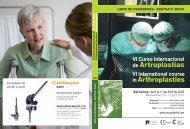cadera / hip - Active Congress.......
cadera / hip - Active Congress.......
cadera / hip - Active Congress.......
Create successful ePaper yourself
Turn your PDF publications into a flip-book with our unique Google optimized e-Paper software.
VIERNES / FRIDAY<br />
268<br />
MIS TKA. The Mini-Midvastus and the Modifi<br />
ed Mini-Subvastus can be techniques which<br />
can be applied to all patients regardless age,<br />
weight, and deformity.<br />
MIS KNEE. A SOFT<br />
TISSUE OPERATION?<br />
H. Delport<br />
Head Departament of Orthopaedics.<br />
AZ Waasland Sint Niklaas, Belgium<br />
The hype of MIS has resulted in the observation<br />
that most surgeons have reduced their<br />
incisions to smaller ones.<br />
Failure in alignment and position of the components<br />
is always visible on x-rays. Other non<br />
visible anatomic structures (nerves,vessels,<br />
ligaments,etc.) are at risk during the procedure<br />
and should be respected.<br />
Damaging the cutaneous nerves of the knee<br />
region can eventually lead to neurinoma<br />
formation. This not only gives raise to numb<br />
areas but occasionally can cause extreme<br />
pain.<br />
Some approaches are infl uencing the innervation<br />
of the vastus medialis. Different<br />
patterns of this nerve can be described.<br />
Saving the supra- and infra-patellar fat pad<br />
has several benefi ts. This is important for<br />
the patellar blood supply, but also has biomechanical<br />
implications.<br />
The medial supporting structures are to be<br />
respected. Care should also be taken to the<br />
postero-latertal corner during the balancing<br />
and releasing action in this area.<br />
Always remember the minimal distance between<br />
the posterior capsule and the popliteal<br />
arterty in extension and fl exion. As shown by<br />
prof.M.Prettenklieber (Vienna) the distance<br />
between the joint capsule and the popliteal<br />
artery is subject to a high degree of variations<br />
and ranges from 2 to 37 mm. It may even<br />
decrease in fl exion !<br />
Our message is :please take care of the<br />
important soft tissues during MIS Total Knee<br />
Replacement.<br />
PITFALLS OF MIS TKA<br />
D. A. Dennis, M.D.<br />
Adjunct Professor, Dept. of Biomedical<br />
Engineering, University of Tennessee<br />
Assistant Clinical Professor, University<br />
of Colorado Health Sciences Center<br />
Clinical Director, Rocky Mountain Musculoskeletal<br />
Research Laboratory<br />
Denver, Colorado, USA<br />
I. TKA Goals<br />
A. Optimize Function & Survivors<strong>hip</strong><br />
B. Accelerate Recovery<br />
1. As Long As No Compromise In Function<br />
or Survivors<strong>hip</strong>!!<br />
II. MIS TKA Proposed Advantages<br />
A. Quicker Recovery<br />
B. Reduced Length of Stay<br />
C. Reduced Blood Loss<br />
D. Better Early Quad Function<br />
E. Less Discomfort<br />
III. MIS TKA Potential Disadvantages<br />
A. Component Malposition<br />
B. Inferior Ligamentous Balance<br />
C. Inferior Cementation / Fixation<br />
D. Inferior Long Term Results<br />
E. Increased Perioperative Complications<br />
IV. Author’s Hypotheses<br />
A. Quicker Recovery / ↓ Length of Stay<br />
Overstated<br />
B. ↑ Technical Errors & Complications Will<br />
Occur Resulting In Inferior Long-Term<br />
Clinical Results With Technology and<br />
Techniques Currently Utilized<br />
V. Complications I’ve Observed<br />
A. Component Loosening (18 Months<br />
Postop)





